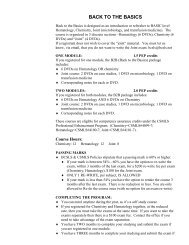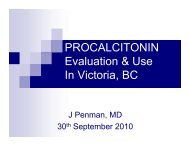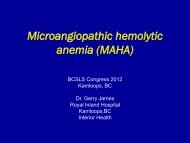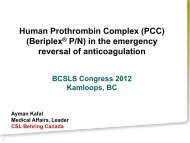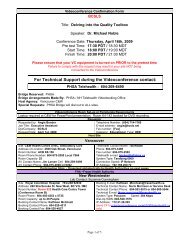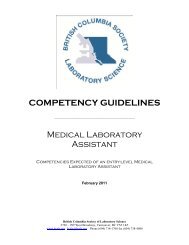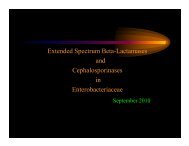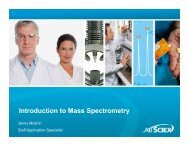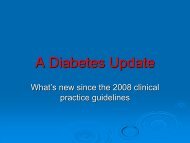Quality Management for the Medical Laboratory - the British ...
Quality Management for the Medical Laboratory - the British ...
Quality Management for the Medical Laboratory - the British ...
You also want an ePaper? Increase the reach of your titles
YUMPU automatically turns print PDFs into web optimized ePapers that Google loves.
<strong>Quality</strong> <strong>Management</strong><br />
<strong>for</strong> <strong>the</strong> <strong>Medical</strong> <strong>Laboratory</strong><br />
Michael Noble MD FRCPC<br />
Chair – Program Office <strong>for</strong> <strong>Laboratory</strong> <strong>Quality</strong> <strong>Management</strong><br />
<strong>Medical</strong> Director <strong>for</strong> <strong>Quality</strong> – LifeLabs BC<br />
2/20/2009 1
Books Worth Reading<br />
• The Deming Method by M. Walton (1986)<br />
• ISO 9001:2000 Essentials – CSA<br />
• ISO 15189:2003 Essentials – CSA<br />
• CLSI HS1- A <strong>Quality</strong> <strong>Management</strong> System<br />
Model <strong>for</strong> Health Care<br />
• CLSI GP26:A3 - Application of a <strong>Quality</strong><br />
• <strong>Management</strong> System Model <strong>for</strong> <strong>Laboratory</strong><br />
Services<br />
2/20/2009 2
Outline<br />
• Why <strong>Medical</strong> Labs need <strong>Quality</strong> <strong>Management</strong><br />
• Abbreviated History of <strong>Quality</strong> <strong>Management</strong><br />
• History’s evolution to Standards and Guidelines<br />
• <strong>Quality</strong> Partnerships<br />
• Progress to <strong>the</strong> <strong>Quality</strong> Toolbox<br />
2/20/2009 3
Seventy percent of<br />
clinical medicine decision making is<br />
predicated upon, or confirmed by,<br />
or documented by<br />
medical laboratory test results.<br />
Dighe, A. S.,<br />
Medicolegal liability in laboratory medicine,<br />
Semin Diagn Pathol, 2007<br />
2/20/2009 4
• In <strong>the</strong> United States <strong>the</strong>re are between 7<br />
and 10 Billion laboratory tests reported<br />
annually.<br />
Boone DJ, IQLM, 2005<br />
• 15% of patients in a 5 country study receive<br />
ei<strong>the</strong>r incorrect or delayed reports on<br />
abnormal results.<br />
Boone DJ, IQLM, 2005<br />
2/20/2009 5
<strong>Management</strong><br />
by <strong>the</strong><br />
Moment<br />
2/20/2009 6
You can try to fix <strong>the</strong>m…<br />
<strong>Management</strong><br />
by <strong>the</strong><br />
Moment<br />
2/20/2009 7
But <strong>the</strong>y never go away!<br />
<strong>Management</strong><br />
by <strong>the</strong><br />
Moment<br />
2/20/2009 8
So <strong>the</strong> better approach is…<br />
An systemic approach of<br />
organization, plan, review, and<br />
action gives you <strong>the</strong><br />
best chance of success.<br />
2/20/2009 9
Why <strong>Medical</strong> Labs need <strong>Quality</strong><br />
<strong>Management</strong><br />
• <strong>Medical</strong> Laboratories<br />
– Highly complex operations<br />
– Individuals doing complex tasks<br />
– Absolute need <strong>for</strong> Accuracy<br />
– Absolute need <strong>for</strong> Confidentiality<br />
– Absolute need <strong>for</strong> Time Effectiveness<br />
– Absolute need <strong>for</strong> Cost Effectiveness<br />
2/20/2009 10
<strong>Quality</strong> <strong>Management</strong> is not new<br />
1922 - Walter Shewhart<br />
Western Electric<br />
Bell Telephone Laboratories<br />
Statistical Process Control<br />
ACT<br />
PLAN<br />
CHECK<br />
DO<br />
2/20/2009 11
<strong>Management</strong> Principles<br />
1940 - J Edwards Deming - The Fourteen Points<br />
1. Create constancy of purpose of product and service<br />
2. Adopt a new philosophy (mistakes are unacceptable)<br />
3. Cease dependence on mass inspection<br />
4. Stop <strong>the</strong> process of awarding business on price alone.<br />
5. Improve constantly and <strong>for</strong>ever <strong>the</strong> production and service<br />
6. Institute training<br />
7. Institute leadership<br />
8. Drive out fear<br />
9. Break down barriers between staff areas.<br />
10. Eliminate slogans and targets<br />
11. Eliminate numerical quotas<br />
12. Remove barriers to pride in workmanship<br />
13. Institute vigorous education and retraining<br />
14. Take action to accomplish <strong>the</strong> trans<strong>for</strong>mation<br />
2/20/2009 12
J Edwards Demining – The seven deadly diseases<br />
1. Lack of constancy of purpose<br />
2. Emphasis on short term profits<br />
3. Evaluation by per<strong>for</strong>mance<br />
4. Mobility of <strong>Management</strong><br />
5. Running a company on visible figures alone.<br />
6. Excessive medical costs.<br />
7. Excessive costs or warranty.<br />
2/20/2009 13
• In <strong>the</strong> U.S. industry did not want to listen<br />
• But Japan did. Deming visits<br />
Japan<br />
electronics<br />
US Automotive<br />
US<br />
electronics<br />
Motorola<br />
Digital<br />
Japan automotive<br />
1920 1940 1960 1980 2000 2010<br />
2/20/2009 14
Philip Crosby<br />
1926-2001<br />
Doing it right <strong>the</strong> first time<br />
THE FOUR ABSOLUTES<br />
• <strong>Quality</strong> is con<strong>for</strong>mance to requirements<br />
• The system of <strong>Quality</strong> is prevention.<br />
• The per<strong>for</strong>mance standard is zero defects<br />
• The measurement of quality is <strong>the</strong> price of<br />
non-con<strong>for</strong>mity.<br />
2/20/2009 15
Philip Crosby<br />
1926-2001<br />
Doing it right <strong>the</strong> first time<br />
• <strong>Quality</strong> is con<strong>for</strong>mance to requirements<br />
Who sets <strong>the</strong> requirements?<br />
Regulators<br />
Respected Authority<br />
Professional Bodies<br />
Customers<br />
Internal Audit<br />
2/20/2009 16
Standards Development<br />
BSI<br />
US Military<br />
ABCA<br />
NATO<br />
ISO<br />
ISO 9000<br />
ISO 17025<br />
ISO 15189<br />
CDC<br />
CLSI<br />
WHO<br />
Shewhart<br />
Deming<br />
THE<br />
WORLD<br />
2/20/2009 17
Standards and<br />
<strong>Quality</strong> <strong>Management</strong><br />
Organization<br />
&<br />
<strong>Management</strong><br />
Facilities<br />
Personnel<br />
Customer<br />
Satisfaction<br />
<strong>Quality</strong><br />
<strong>Management</strong><br />
Documentation<br />
&<br />
Control<br />
Continual<br />
Improvement<br />
Assessment<br />
Technical<br />
2/20/2009 18
Standards and<br />
<strong>Quality</strong> <strong>Management</strong><br />
Environment and<br />
Safety<br />
Responsibility<br />
Authority<br />
Organization<br />
&<br />
<strong>Management</strong><br />
Facilities<br />
Personnel<br />
Training and<br />
Competency<br />
Customer<br />
Satisfaction<br />
Continual<br />
Improvement<br />
Monitor<br />
Audit<br />
Review<br />
<strong>Quality</strong><br />
<strong>Management</strong><br />
Assessment<br />
Technical<br />
Documentation<br />
&<br />
Control<br />
Policy<br />
Process<br />
SOPs<br />
Supply Chain<br />
Inventory<br />
Equipment<br />
Testing<br />
Collection<br />
Reporting<br />
2/20/2009 19
So what happens if you focus all<br />
your energy on one component<br />
Organization<br />
&<br />
<strong>Management</strong><br />
Facilities<br />
Personnel<br />
Customer<br />
Satisfaction<br />
<strong>Quality</strong><br />
<strong>Management</strong><br />
Documentation<br />
&<br />
Control<br />
Continual<br />
Improvement<br />
Assessment<br />
Technical<br />
2/20/2009 20
The system starts to fall apart<br />
QUICKLY<br />
Organization<br />
&<br />
<strong>Management</strong><br />
Facilities<br />
Personnel<br />
Customer<br />
Satisfaction<br />
<strong>Quality</strong><br />
<strong>Management</strong><br />
Documentation<br />
&<br />
Control<br />
Continual<br />
Improvement<br />
Assessment<br />
Technical<br />
2/20/2009 21
But if <strong>the</strong>re is ONE to spend a LOT<br />
of time with…<br />
Organization<br />
&<br />
<strong>Management</strong><br />
Facilities<br />
Personnel<br />
Customer<br />
Satisfaction<br />
<strong>Quality</strong><br />
<strong>Management</strong><br />
Documentation<br />
&<br />
Control<br />
Continual<br />
Improvement<br />
Assessment<br />
Technical<br />
2/20/2009 22
But if <strong>the</strong>re is ONE to spend a LOT<br />
of time with…<br />
Organization<br />
&<br />
<strong>Management</strong><br />
Facilities<br />
Personnel<br />
Customer<br />
Satisfaction<br />
<strong>Quality</strong><br />
<strong>Management</strong><br />
Documentation<br />
&<br />
Control<br />
Continual<br />
Technical<br />
Improvement<br />
Assessment<br />
2/20/2009 23
Continual Improvement through<br />
audit and assessment<br />
Internal<br />
Audits<br />
<strong>Quality</strong><br />
Control<br />
I<br />
N<br />
T<br />
E<br />
R<br />
N<br />
A<br />
L<br />
ASSESSMENT<br />
E<br />
X<br />
T<br />
E<br />
R<br />
R<br />
N<br />
A<br />
L<br />
Accredi<br />
-tation<br />
EQA<br />
2/20/2009 24
Continual Improvement through<br />
Addressing and Preventing error<br />
METRICS<br />
(<strong>Quality</strong> Indicators)<br />
ERROR – OFI- NON-CONFORMITY<br />
Investigate <strong>for</strong>:<br />
Impact – Underlying Cause - Risk<br />
REMEDIAL<br />
CORRECTIVE<br />
EVALUATE<br />
EFFECTIVENESS<br />
PREVENTIVE<br />
MANAGEMENT<br />
REVIEW
Continual Improvement through<br />
continuing education<br />
2/20/2009 26
CLSI <strong>Quality</strong> <strong>Management</strong><br />
HS01:2001<br />
2/20/2009 27
A quality story…<br />
EQALM 2007<br />
A Pathologist from London gave a presentation<br />
on how he felt <strong>the</strong> great responsibility <strong>for</strong> being<br />
<strong>the</strong> sole person responsible <strong>for</strong> <strong>the</strong> quality of<br />
his medical laboratory.<br />
2/20/2009<br />
28
A quality story…<br />
EQALM 2007<br />
A Pathologist from London gave a presentation<br />
on how he felt <strong>the</strong> great responsibility <strong>for</strong> being<br />
<strong>the</strong> sole person responsible <strong>for</strong> <strong>the</strong> quality of his<br />
medical laboratory.<br />
He felt no relief when he was in<strong>for</strong>med that<br />
while he was clearly important he was far from<br />
being <strong>the</strong> sole driver of his laboratory’s quality.<br />
2/20/2009<br />
29
<strong>Quality</strong> Partnerships<br />
<strong>Laboratory</strong><br />
<strong>Management</strong><br />
Standards<br />
Development<br />
Bodies<br />
<strong>Laboratory</strong><br />
<strong>Quality</strong><br />
<strong>Management</strong><br />
Accreditation<br />
Bodies<br />
2/20/2009<br />
30
<strong>Quality</strong> Partnerships<br />
Reagents<br />
Supplies<br />
Manufacturers<br />
Equipment<br />
Manufacturers<br />
External<br />
<strong>Quality</strong><br />
Assessment<br />
Bodies<br />
<strong>Laboratory</strong><br />
<strong>Management</strong><br />
<strong>Laboratory</strong><br />
<strong>Quality</strong><br />
<strong>Management</strong><br />
Accreditation<br />
Bodies<br />
2/20/2009<br />
Professions<br />
Guidelines<br />
Committee<br />
Standards<br />
Development<br />
Bodies<br />
31
<strong>Quality</strong> Partnerships<br />
Equipment<br />
Manufacturers<br />
THE<br />
PUBLIC<br />
Accreditation<br />
Bodies<br />
<strong>Laboratory</strong><br />
<strong>Management</strong><br />
<strong>Laboratory</strong><br />
<strong>Quality</strong><br />
<strong>Management</strong><br />
External<br />
<strong>Quality</strong><br />
Assessment<br />
Bodies<br />
2/20/2009<br />
Reagents<br />
Supplies<br />
Manufacturers<br />
Professions<br />
Guidelines<br />
Committees<br />
Standards<br />
Development<br />
Bodies<br />
32
<strong>Quality</strong> Partnerships<br />
<strong>Laboratory</strong><br />
<strong>Management</strong><br />
Equipment<br />
Manufacturers<br />
Reagents<br />
Supplies<br />
Manufacturers<br />
THE<br />
PUBLIC<br />
<strong>Laboratory</strong><br />
<strong>Quality</strong><br />
<strong>Management</strong><br />
Professions<br />
Guidelines<br />
Committees<br />
Accreditation<br />
Bodies<br />
Standards<br />
Development<br />
Bodies<br />
External<br />
<strong>Quality</strong><br />
Assessment<br />
Bodies<br />
2/20/2009<br />
When <strong>the</strong> Public shines a light on laboratory quality,<br />
smart laboratories listen<br />
33
Partners who can provide help<br />
2/20/2009<br />
34
Organizations: <strong>the</strong> quality network<br />
ASQ US www.asq.org Website in<strong>for</strong>mation (Free), documents ($)<br />
CLSI US www.clsi.org Document access ($)<br />
CMPT BC www.cmpt.ca Website in<strong>for</strong>mation (Free),<br />
CSA CAN www.csa.ca Website in<strong>for</strong>mation (Free), documents ($)<br />
DAP BC www.dap.org Website in<strong>for</strong>mation (Free)<br />
ISO INT www.iso.org Website in<strong>for</strong>mation (Free), documents ($)<br />
POLQM BC www.polqm.ca Website in<strong>for</strong>mation (Free),<br />
QMPLS ONT www.qmpls.org Website in<strong>for</strong>mation (Free),<br />
documents (Free),<br />
SCC CAN www.scc.ca Website in<strong>for</strong>mation (Free), documents ($)<br />
2/20/2009<br />
35
Organizations: <strong>the</strong> quality network<br />
ASQ US www.asq.org Website in<strong>for</strong>mation (Free), documents ($)<br />
CLSI US www.clsi.org Document access ($)<br />
CMPT BC www.cmpt.ca Website in<strong>for</strong>mation (Free),<br />
CSA CAN www.csa.ca Website in<strong>for</strong>mation (Free), documents ($)<br />
DAP BC www.dap.org Website in<strong>for</strong>mation (Free)<br />
ISO Int www.iso.org Website in<strong>for</strong>mation (Free), documents ($)<br />
POLQM BC www.polqm.ca Website in<strong>for</strong>mation (Free),<br />
QMPLS ONT www.qmpls.org Website in<strong>for</strong>mation (Free),<br />
documents (Free),<br />
SCC CAN www.scc.ca Website in<strong>for</strong>mation (Free), documents ($)<br />
2/20/2009<br />
36
Terms and Definitions<br />
Standard:<br />
Broad consensus document.<br />
Authorized by an authoritative body.<br />
Guideline:<br />
Consensus document.<br />
Regulation:<br />
A regulatory (licensure) requirement.<br />
A regulator can cite any source<br />
document.<br />
2/20/2009<br />
37
Many jurisdictions set <strong>the</strong>ir own standards,<br />
guidelines, regulations, requirements<br />
Advantages<br />
– Fast<br />
– Local Orientation<br />
– Local Expertise<br />
– Local Logic<br />
Disadvantages<br />
– Too introspective<br />
– Expertise Gap<br />
– Inconsistent with neighbours<br />
– Lost trade opportunities<br />
– Lost research opportunities<br />
– Credibility Gap<br />
– May exclude opportunities<br />
<strong>for</strong> progress and growth.<br />
2/20/2009 38
Many jurisdictions set <strong>the</strong>ir own standards,<br />
guidelines, regulations, requirements<br />
Advantages<br />
– Fast<br />
– Local Expertise<br />
– Local Circumstance<br />
Disadvantages<br />
– Too introspective<br />
– Expertise Gap<br />
– Inconsistent with neighbours<br />
– Lost trade/research<br />
opportunities<br />
– Credibility Gap<br />
– May become to detailed<br />
(vertical)<br />
LOTS OF ADVANTAGES TO SHARED DOCUMENTS<br />
2/20/2009 39
A Brief History…<br />
• 1995<br />
The International Organization <strong>for</strong><br />
Standardization (ISO) (at <strong>the</strong> request of <strong>the</strong><br />
United States) invited <strong>the</strong> international medical<br />
laboratory community to a meeting in<br />
Philadelphia to discuss <strong>the</strong> possibility of a single<br />
harmonizing standard <strong>for</strong> medical laboratories<br />
– Attended by 33 countries from North America, South<br />
America, Europe, Asia, Australasia.<br />
2/20/2009<br />
40
ISO Technical Committee 212<br />
Clinical laboratory testing and in vitro diagnostic test systems<br />
• 33 participating countries<br />
• Argentina ( IRAM )<br />
• Australia ( SA )<br />
• Austria ( ON )<br />
• Belgium ( NBN )<br />
• Brazil ( ABNT )<br />
• Canada ( SCC )<br />
• Chile ( INN )<br />
• China ( SAC )<br />
• Czech Republic ( CNI )<br />
• Denmark ( DS )<br />
• Finland ( SFS )<br />
• France ( AFNOR )<br />
• Germany ( DIN )<br />
• Iran, Islamic Republic of ( ISIRI )<br />
• Ireland ( NSAI )<br />
• Israel ( SII )<br />
• Italy ( UNI )<br />
• Jamaica ( BSJ )<br />
• Japan ( JISC )<br />
• Korea, Republic of ( KATS )<br />
• Malaysia ( DSM )<br />
• Mexico ( DGN )<br />
• Ne<strong>the</strong>rlands ( NEN )<br />
• New Zealand ( SNZ )<br />
• Norway ( SN )<br />
• Portugal ( IPQ )<br />
• Singapore ( SPRING SG )<br />
• Spain ( AENOR )<br />
• Sweden ( SIS )<br />
• Trinidad and Tobago ( TTBS )<br />
• Turkey ( TSE )<br />
• United Kingdom ( BSI )<br />
2/20/2009<br />
41
ISO Technical Committee 212<br />
Clinical laboratory testing and in vitro diagnostic test systems<br />
• 18 observing<br />
countries<br />
• Bulgaria ( BDS )<br />
• Croatia ( HZN )<br />
• Cuba ( NC )<br />
• Cyprus ( CYS )<br />
• Egypt ( EOS )<br />
• Estonia ( EVS )<br />
• Hong Kong, China (<br />
ITCHKSAR )<br />
• Hungary ( MSZT )<br />
• India ( BIS )<br />
• Luxembourg ( ILNAS )<br />
• Malta ( MSA )<br />
• Mongolia ( MASM )<br />
• Russian Federation (<br />
GOST R )<br />
• Saudi Arabia ( SASO )<br />
• Switzerland ( SNV )<br />
• Thailand ( TISI )<br />
• Uruguay ( UNIT )<br />
• Zimbabwe ( SAZ )<br />
2/20/2009<br />
42
The meeting was attended <strong>the</strong> by<br />
international community of laboratorians<br />
• Laboratorians<br />
• Accreditation bodies<br />
• <strong>Medical</strong> Device Manufacturers<br />
• Metrologists<br />
• Calibration authorities<br />
• <strong>Medical</strong> <strong>Laboratory</strong> Consultants<br />
• Organizational Representatives<br />
– CAP, WHO, WASP, OECD,EDMA, IBWM,ELM,IFCC, ILAC<br />
2/20/2009 43
ISO Technical Committee 212<br />
• Working Groups<br />
•1- <strong>Quality</strong> and competence in <strong>the</strong> medical laboratory<br />
•2- Reference systems<br />
•3- In vitro diagnostic products<br />
•4- Antimicrobial susceptibility testing<br />
2/20/2009 44
Canadian Participation in<br />
ISO Technical Committee 212<br />
• Canadian Advisory Committee to ISO TC 212<br />
• Required by Standards Council of Canada<br />
• Hosted by Canadian Standards Association<br />
• Participates in all four working groups<br />
• Representatives from all laboratory disciplines.<br />
• Regional representation<br />
• Also responsible <strong>for</strong> CSA standards <strong>for</strong> medical<br />
laboratories (fume hoods, safety cabinets, sharps containers).<br />
2/20/2009 45
Standards Developed by ISO TC 212<br />
• Seventeen standards in <strong>the</strong> areas of<br />
– <strong>Laboratory</strong> <strong>Quality</strong> <strong>Management</strong><br />
– Safety<br />
– Risk<br />
– Point of Care<br />
– Calibrators<br />
– Validation<br />
– Susceptibility Testing<br />
– Traceability<br />
– Label Symbols<br />
• Canadian lead writing teams<br />
2/20/2009<br />
46
ISO 15189<br />
The<br />
international standard<br />
<strong>for</strong> medical<br />
laboratory<br />
quality and<br />
competence<br />
2/20/2009<br />
47
Laboratories and <strong>the</strong>ir standards:<br />
similar but different<br />
2/20/2009<br />
48
ISO 15189:2007<br />
spans <strong>the</strong> world<br />
2/20/2009 49
Not all laboratories are <strong>the</strong> same<br />
<strong>Medical</strong><br />
A laboratory of many integrated procedures<br />
intended <strong>for</strong> diagnosis, confirmation,<br />
documentation of human health in<strong>for</strong>mation<br />
Community<br />
Hospital<br />
Public Health<br />
Testing<br />
Calibration<br />
A laboratory of limited stand-alone procedures<br />
intended to confirm con<strong>for</strong>mity of a product to its<br />
expected target or goal<br />
A laboratory of a very limited range of<br />
procedures intended to ensure traceability of<br />
equipment or material to highest level possible.<br />
Manufacturing<br />
Electrical<br />
Water<br />
Food<br />
Mining<br />
Public Health<br />
Reference<br />
NIST<br />
2/20/2009<br />
50
ISO 15189:2007<br />
<strong>Medical</strong> Laboratories – particular requirements <strong>for</strong> quality and competence.<br />
• First published in 2003<br />
• Adopted as a Canadian National Standard<br />
• Adopted as <strong>the</strong> basis <strong>for</strong> provincial accreditation in<br />
Ontario, Quebec, Atlantic Canada<br />
• Recognized as <strong>the</strong> source <strong>for</strong> quality management in<br />
requirements Alberta, Saskatchewan, Manitoba.<br />
• Recognized as a source of quality management<br />
requirements in <strong>British</strong> Columbia<br />
• <strong>Quality</strong> and competence are holistic issues.<br />
• 15189 is not laboratory discipline specific.<br />
2/20/2009<br />
51
ISO 15189 requirements<br />
<strong>Management</strong> Requirements<br />
1. Organization<br />
2. <strong>Quality</strong> <strong>Management</strong> System<br />
3. Document Control<br />
4. Review of Contracts<br />
5. Referral Laboratories<br />
6. External Services and Supplies<br />
7. Identification and control of<br />
non-con<strong>for</strong>mities<br />
8. Corrective Actions<br />
9. Preventive Actions<br />
10. Continual Improvement<br />
11. <strong>Quality</strong> and Technical Records<br />
12. Internal Audits<br />
13. <strong>Management</strong> Review<br />
Technical Requirements<br />
1. Personnel<br />
2. Accommodation / environment<br />
3. <strong>Laboratory</strong> Equipment<br />
4. Pre-examination procedures<br />
5. Examination procedures<br />
6. Assuring quality of examinations<br />
7. Post-examination procedures<br />
8. Reporting Results<br />
2/20/2009<br />
52
15189 Examples<br />
• Organization<br />
– A medical laboratory shall be a legal entity.<br />
– <strong>Medical</strong> laboratories shall be designed to meet patient needs.<br />
– <strong>Laboratory</strong> personnel responsibilities shall be defined.<br />
– <strong>Laboratory</strong> management shall provide personnel with <strong>the</strong><br />
resources and authority to per<strong>for</strong>m <strong>the</strong>ir duties.<br />
– <strong>Laboratory</strong> policies and procedures shall protect confidential<br />
in<strong>for</strong>mation.<br />
– The laboratory shall appoint a quality manager.<br />
– The laboratory shall have technical management <strong>for</strong> overall<br />
responsibility of technical operations and <strong>the</strong> provision of<br />
resources needed to ensure <strong>the</strong> required quality of laboratory<br />
procedures.<br />
2/20/2009<br />
53
15189 and <strong>the</strong> <strong>Laboratory</strong> Director<br />
• The laboratory shall be directed by a person or persons having<br />
executive responsibility and <strong>the</strong> competence to assume<br />
responsibility <strong>for</strong> <strong>the</strong> services provided. (note: competence is <strong>the</strong><br />
product of basic, academic, postgraduate, continuing education, and<br />
training and experience of several years in a medical laboratory).<br />
• The laboratory director shall be responsible <strong>for</strong> professional,<br />
scientific, consultative or advisory organization, administrative<br />
and educational matters.<br />
• The laboratory director need not per<strong>for</strong>m all<br />
responsibilities personally. However it is <strong>the</strong> laboratory<br />
director who remains responsible <strong>for</strong> <strong>the</strong> overall<br />
operation and administration of <strong>the</strong> laboratory, <strong>for</strong><br />
ensuring quality services provided <strong>for</strong> patients.<br />
2/20/2009<br />
54
15189 and <strong>Management</strong> Review<br />
• <strong>Laboratory</strong> management shall review <strong>the</strong> laboratory’s quality<br />
management system and all of its medical services, including<br />
examination and advisory activities to ensure <strong>the</strong>ir continuing<br />
suitability and effectiveness in support of patient care and to<br />
introduce any necessary changes or improvements.<br />
• The results of <strong>the</strong> review shall be incorporated into a plan that<br />
includes goals, objectives and action plans.<br />
• The typical period <strong>for</strong> conducting a management review is once<br />
every twelve months.<br />
• <strong>Management</strong> review shall take into account, follow-up of previous<br />
review, status of corrective actions, reports from managers and<br />
supervisors, internal audits, assessments of external bodies, quality<br />
indicators, outcome of EQA, feedback (complaints), noncon<strong>for</strong>mities,<br />
continual improvement processes, evaluation of<br />
suppliers.<br />
2/20/2009<br />
55
15189 and Personnel<br />
• <strong>Laboratory</strong> management shall have an organization plan, personnel<br />
policies and job descriptions that define qualifications and duties<br />
<strong>for</strong> all personnel.<br />
• <strong>Laboratory</strong> management shall authorize personnel to per<strong>for</strong>m<br />
particular tasks.<br />
• Personnel shall have training specific to quality assurance and<br />
quality management <strong>for</strong> services offered.<br />
• There shall be a continuing education program available to staff at<br />
all levels.<br />
• Employees shall be trained to prevent or contain <strong>the</strong> effects of<br />
adverse incidents.<br />
• The competency of each person to per<strong>for</strong>m assigned tasks shall be<br />
assessed following training and periodically <strong>the</strong>reafter. Retraining<br />
and reassessment shall occur when necessary.<br />
2/20/2009<br />
56
15189 and <strong>the</strong> <strong>Quality</strong> Manager<br />
• The laboratory shall appoint a quality manager with<br />
delegated responsibility and authority to oversee<br />
compliance with <strong>the</strong> requirements of <strong>the</strong> quality<br />
management system.<br />
• The quality manager shall report directly to <strong>the</strong> level of<br />
laboratory management at which decisions are made<br />
on laboratory policy and resources.<br />
• The quality manager shall plan, organize and conduct<br />
internal audits.<br />
2/20/2009<br />
57
Addressing error<br />
Establish<br />
Mechanisms of Detection<br />
Investigate <strong>for</strong>:<br />
Impact – Underlying Cause - Risk<br />
REMEDIAL<br />
CORRECTIVE<br />
EVALUATE<br />
EFFECTIVENESS<br />
PREVENTIVE<br />
MANAGEMENT<br />
REVIEW<br />
2/20/2009 58
So, what can you say about quality<br />
management and ISO15189?<br />
• Very broad document.<br />
• Consistent with <strong>the</strong> history and tradition of<br />
quality management (PDCA, 14 Essentials, 4<br />
Absolutes).<br />
• Gaining much international use and respect.<br />
• In one <strong>for</strong>m or ano<strong>the</strong>r, all laboratory physicians<br />
will be dealing directly and indirectly with <strong>the</strong><br />
requirements cited in this document.<br />
2/20/2009 59
The <strong>Quality</strong> Toolbox<br />
Lean<br />
Six Sigma<br />
Surveys<br />
RISK<br />
FMEA<br />
Metrics<br />
Statistics<br />
The <strong>Quality</strong> Toolbox<br />
The <strong>Quality</strong> Toolbox
Tools in <strong>the</strong> Toolbox<br />
• Mega-Tools<br />
– Lean<br />
– Six Sigma<br />
– Priority Matrices and<br />
Risk Assessment<br />
• Tools/Techniques<br />
– Balanced Scorecards<br />
– Brainstorming<br />
– Control Charting<br />
– Flow Charting<br />
– <strong>Quality</strong> Indicators<br />
–Surveys
Venetian<br />
Ship<br />
Building<br />
Historical References to LEAN<br />
Benjamin<br />
Franklin<br />
Inventory<br />
waste<br />
Eli<br />
Whitney<br />
replacement<br />
parts<br />
1915<br />
Henry Ford<br />
Deming<br />
Juran<br />
1950<br />
Toyota<br />
Taiichi Ohno<br />
Industry<br />
1988<br />
Health<br />
Care<br />
2000<br />
Frank<br />
Gilbreth<br />
motion<br />
studies
Henry Ford<br />
• Model T<br />
• 1908-1915<br />
• The automotive<br />
assembly line<br />
– 7 years in<br />
development.<br />
– A “slaughterhouse in<br />
reverse”.<br />
– Mass production by<br />
moving <strong>the</strong> product to<br />
<strong>the</strong> worker.<br />
•Faster<br />
– 12.5 to 1.5 worker hours/car<br />
•Safer<br />
– Workers not roaming with tools<br />
•Cheaper<br />
– Reduced unit pricing <strong>for</strong> cars<br />
•Worker benefit<br />
– Highly paid salaries to workers<br />
Unintended consequences both<br />
positive and negative shaped<br />
and reshaped <strong>the</strong> world.
Taiichi Ohno<br />
• Toyota Production System<br />
– American Influences<br />
• Ford Motor Company<br />
– Excessive inventory<br />
– Workload was excessive and uneven<br />
• Piggly Wiggly Foods<br />
– Reordering and restocking inventory when needed<br />
– Just in Time ordering.<br />
• TPS is designed to<br />
– remove overburden (muri) and inconsistency (mura),<br />
and eliminate waste (muda).
TPS Philosophy<br />
• The right process will produce <strong>the</strong> right results<br />
– Build a culture of stopping to fix problems, to get quality right <strong>the</strong> first time<br />
– Standardized tasks are <strong>the</strong> foundation <strong>for</strong> continuous improvement and<br />
employee empowerment<br />
– Use only reliable, thoroughly tested technology that serves your people and<br />
processes.<br />
• Add value to <strong>the</strong> organization by developing your people and partners<br />
– Grow leaders who thoroughly understand <strong>the</strong> work, live <strong>the</strong> philosophy, and<br />
teach it to o<strong>the</strong>rs.<br />
– Develop exceptional people and teams who follow your company's philosophy.<br />
– Respect your extended network of partners and suppliers by challenging <strong>the</strong>m<br />
and helping <strong>the</strong>m improve.<br />
• Continuously solving root problems drives organizational learning<br />
– Go and see <strong>for</strong> yourself to thoroughly understand <strong>the</strong> situation Make decisions<br />
slowly by consensus, thoroughly considering all options; implement decisions<br />
rapidly;<br />
– Become a learning organization through relentless reflection and continuous<br />
improvement.
TPS (LEAN) JARGON<br />
Muri, Mura, Muda<br />
Seiri, Seiton,Seiso,<br />
Seiketsu, Shitsuke<br />
Five S<br />
Value Streams<br />
Kanban<br />
Kaizen<br />
Poka Yoke<br />
Gemba<br />
Overburden, Inconsistency, Waste<br />
Sort, Straighten, Shine, Standardize, Sustain<br />
Keep what you need; throw out <strong>the</strong> rest.<br />
A place <strong>for</strong> everything and everything in its place.<br />
Keep your workplace neat and clean.<br />
Keep work practices consistent<br />
Maintain and review your standards<br />
Tracing <strong>the</strong> Work Flow: Maximize Value – Eliminate waste<br />
“Pull” per<strong>for</strong>mance – Piggly Wiggly Per<strong>for</strong>mance<br />
Reflection and Continuous Improvement<br />
Error Proofing<br />
Go and See
Value Streams<br />
Activity trans<strong>for</strong>ms - waiting is waste<br />
Activity flows through pools of waste<br />
Customers value active trans<strong>for</strong>mation and abhor waste
Value streaming:<br />
IDENTIFYING PROCESS WASTE<br />
COLLECTION<br />
ACCESS<br />
AVAILABILITY<br />
COMPETANCY<br />
INVENTORY<br />
PROCESS<br />
MONITORING<br />
AVAILABILITY<br />
ORDER<br />
DELIVER<br />
CHECKING<br />
PROCESS<br />
VERIFICATION<br />
VALIDATION<br />
TRANSPORT<br />
ACCESS<br />
AVAILABILITY<br />
ACTIVITY<br />
ACCURACY<br />
TESTING<br />
PROCESS<br />
PERSONNEL<br />
EQUIPMENT<br />
WORKSPACE<br />
ENVIROMENT<br />
INTERPRETATION<br />
PROCESS<br />
CLINICAL<br />
RELEVANCY
Process Mapping<br />
Pre-Examination Procedures<br />
Physician Phlebotomists Accessioning<br />
See patient<br />
Go to station<br />
Find chart<br />
Find order page<br />
Write order<br />
Flag chart<br />
Put in right pile<br />
Check order<br />
Transcribe order<br />
Contact lab<br />
Phlebotomist leaves<br />
Phlebotomist goes to<br />
ward<br />
Check room<br />
Find patient<br />
Check armband<br />
Check order<br />
Check requisition<br />
Check tubes<br />
Draw blood<br />
Check tubes<br />
Sign off requisition<br />
Time punch requisition<br />
Package Tubes<br />
Transport tubes<br />
Sample checked in<br />
Requisition time<br />
punched<br />
Sample unpackaged<br />
Tubes confirmed<br />
Tube numbers created<br />
Tubes number labeled<br />
Tube tops removed<br />
Centrifugation<br />
Aloquoting
IDENTIFYING WASTE IN<br />
LABORATORY TESTING<br />
• WAITING <strong>for</strong> a test order<br />
• WAITING <strong>for</strong> a requisition<br />
• WAITING to collect a sample<br />
• WAITING to transport a sample<br />
• WAITING to accession a sample<br />
• WAITING to start processing a sample<br />
• MOVING to collect reagents at a distant location<br />
• MOVING from one work station to an<strong>the</strong>r<br />
• SEARCHING <strong>for</strong> an instrument or material essential <strong>for</strong> processing a<br />
sample<br />
• WAITING to complete processing a sample<br />
• WAITING to create a report<br />
• CREATING an excessive report<br />
• CREATING an non-interpretable report<br />
• WAITING to transport a report<br />
• WAITING <strong>for</strong> a report to be read<br />
• WAITING <strong>for</strong> report-generated action<br />
• WAITING to contact a report recipient
Reducing WASTE in <strong>the</strong><br />
<strong>Medical</strong> <strong>Laboratory</strong><br />
• At-source Order Entry<br />
• No-wait transport.<br />
• Condensed workspace<br />
• Structured workspace<br />
• Continuous flow processing<br />
• Automated Reporting<br />
• Auto-released reporting<br />
• Auto-interpreted reporting
Reducing WASTE in <strong>the</strong><br />
<strong>Medical</strong> <strong>Laboratory</strong><br />
• At-source Order Entry<br />
• No-wait transport.<br />
• Condensed workspace<br />
• Structured workspace<br />
• Continuous flow processing<br />
• Automated Reporting<br />
• Auto-released reporting<br />
• Auto-interpreted reporting
Reducing WASTE in <strong>the</strong><br />
<strong>Medical</strong> <strong>Laboratory</strong><br />
• Faster data entry<br />
• Faster transport<br />
• Reduced motion<br />
• Faster report<br />
release<br />
• Less tech time<br />
• More entry error<br />
• More transport cost<br />
• More inflexibility<br />
• Less personal<br />
report<br />
• More I.T. time
LEAN’s Kanban trigger system<br />
• A notification system that once activated<br />
triggers a response to start ano<strong>the</strong>r<br />
process going.<br />
• “Think about inventory notification cards”<br />
– If you can see this card, you are soon to run<br />
out of materials. Time to order more.
Poka Yoke: Error Proofing<br />
• Placing workable limits that prevent an<br />
action from going wrong.<br />
• In mechanical systems, it means adding<br />
design features that allow two units to only<br />
work in one position.<br />
• An example in ECG testing<br />
SD
ECG Poka Yoke<br />
R Arm<br />
L. Arm<br />
Foot<br />
Chest<br />
Limb Lead Reversal
POKA YOKE reduces ECG<br />
Errors<br />
RED RIBBON<br />
RIGHT SIDE<br />
R Arm<br />
RIGHT ARM<br />
L. Arm<br />
Foot<br />
RIGHT WAY<br />
Chest
IDENTIFYING PROCESS WASTE<br />
COLLECTION<br />
ACCESS<br />
AVAILABILITY<br />
COMPETANCY<br />
Poka<br />
yoke<br />
INVENTORY<br />
PROCESS<br />
MONITORING<br />
AVAILABILITY<br />
ORDER<br />
DELIVER<br />
CHECKING<br />
PROCESS<br />
VERIFICATION<br />
VALIDATION<br />
Kanban<br />
TRANSPORT<br />
ACCESS<br />
AVAILABILITY<br />
ACTIVITY<br />
ACCURACY<br />
5S<br />
TESTING<br />
PROCESS<br />
PERSONNEL<br />
EQUIPMENT<br />
WORKSPACE<br />
ENVIROMENT<br />
INTERPRETATION<br />
PROCESS<br />
CLINICAL<br />
RELEVANCY
Six Sigma:<br />
Quantitative Continual Improvement
<strong>Quality</strong> <strong>Management</strong><br />
Organization<br />
&<br />
<strong>Management</strong><br />
Facilities<br />
Personnel<br />
Customer<br />
Satisfaction<br />
<strong>Quality</strong><br />
<strong>Management</strong><br />
Documentation<br />
&<br />
Control<br />
Continual<br />
Improvement<br />
Assessment<br />
Technical
When pretty good<br />
is not good enough<br />
• In 1980 Canada Post did a study which<br />
demonstrated that 98 per cent of business<br />
mail was delivered on time<br />
• The conclusion was <strong>the</strong> Canada Post was<br />
working well.<br />
But…
With 2 percent late mail…<br />
• Canada Post delivered 50 Million pieces of<br />
business mail daily.<br />
• Which meant ano<strong>the</strong>r 1 million pieces of<br />
business mail were delivered late.<br />
• And each year 260 million pieces of business<br />
mail were delivered late.<br />
• With 10 million business mail receivers, each<br />
mail receiver could expect at least 2 late<br />
business mail deliveries every month.
Opportunity of Improvement <strong>for</strong><br />
Canada Post<br />
• Implement a quality management system<br />
• Investigate why so many letters were<br />
being delivered late.<br />
• Implement a plan to improve letter<br />
delivery.<br />
• Develop a process <strong>for</strong> continual<br />
improvement
What is <strong>the</strong> Per<strong>for</strong>mance on a<br />
Test?<br />
Sensitivity: 98 percent Specificity: 99 percent<br />
Prevalence in <strong>the</strong> Community of 100,000 people<br />
0.1 per cent<br />
Of 3056 positive tests,<br />
2985 (99.3%) will be FALSE positives<br />
Community of 100,000 with 10 per cent prevalence<br />
Of 10,790 positive tests<br />
990 (9.2%) will be FALSE positive
A March through <strong>Quality</strong> History<br />
BSI<br />
ISO<br />
US Military<br />
ABCA<br />
NATO<br />
ISO 9000<br />
ISO 17025<br />
ISO 15189<br />
CDC<br />
CLSI<br />
WHO<br />
Shewhart<br />
Deming<br />
THE<br />
WORLD
A March through <strong>Quality</strong> History<br />
BSI<br />
ISO<br />
US Military<br />
ABCA<br />
NATO<br />
ISO 9000<br />
ISO 17025<br />
ISO 15189<br />
CDC<br />
CLSI<br />
WHO<br />
Shewhart<br />
Deming<br />
THE<br />
WORLD
Galvin Manufacturing to Motorola<br />
Television<br />
Computer<br />
Parts<br />
Cellular<br />
Telephones<br />
Battery<br />
Eliminator<br />
Radio
Galvin Manufacturing to<br />
Motorola<br />
1986<br />
Six Sigma<br />
Continual Improvement<br />
Cellular<br />
Telephones<br />
Computer<br />
Parts<br />
Television<br />
Battery<br />
Eliminator<br />
Radio
Galvin Manufacturing to<br />
Motorola<br />
Bill Smith – Senior <strong>Quality</strong> Assurance 1986<br />
Robert Galvin - CEO<br />
Six Sigma<br />
Continual Improvement<br />
Cellular<br />
Telephones<br />
Computer<br />
Parts<br />
Television<br />
Battery<br />
Eliminator<br />
Radio
• In <strong>the</strong> U.S. industry did not want to listen<br />
• But Japan did.<br />
Deming visits<br />
Japan<br />
electronics<br />
US Automotive<br />
US<br />
electronics<br />
Motorola<br />
Digital<br />
Japan automotive<br />
1920 1940 1960 1980 2000 2010
Six Sigma Cycle of Improvement<br />
• DMAIC<br />
• Define process improvement goals that are consistent with customer<br />
demands and <strong>the</strong> enterprise strategy.<br />
• Measure key aspects of <strong>the</strong> current process and collect relevant data.<br />
• Analyze <strong>the</strong> data to verify cause-and-effect relationships. Determine what<br />
<strong>the</strong> relationships are, and attempt to ensure that all factors have been<br />
considered.<br />
• Improve or optimize <strong>the</strong> process based upon data analysis using<br />
techniques like Design of experiments.<br />
• Control to ensure that any deviations from target are corrected be<strong>for</strong>e<br />
<strong>the</strong>y result in defects. Set up pilot runs to establish process capability, move<br />
on to production, set up control mechanisms and continuously monitor <strong>the</strong><br />
process.
Comparing Cycles<br />
PLAN<br />
MEASURE<br />
DO<br />
CHECK<br />
ACT<br />
CERTIFY<br />
ORGANIZATION<br />
Shewhart<br />
✔<br />
✔<br />
✔<br />
✔<br />
ISO<br />
✔<br />
✔<br />
✔<br />
✔<br />
✔<br />
✔<br />
Six Sigma<br />
✔<br />
✔<br />
✔<br />
✔<br />
✔<br />
LEAN<br />
✔<br />
✔<br />
✔<br />
✔<br />
✔
Six Sigma Jargon<br />
EXEC<br />
LEAD<br />
Champions<br />
Master Black Belt<br />
Black Belt<br />
Green Belt<br />
Yellow Belt<br />
Team Members
Definitions<br />
Champion<br />
Master Black<br />
Black<br />
Green<br />
Yellow<br />
The Six Sigma Boss<br />
Assigns and is Responsible <strong>for</strong> All Projects<br />
Hands on expert.<br />
Mentors Black Belts and Below<br />
4-8 weeks of training<br />
Full time team leader<br />
Lead at least 1 major project to completion<br />
2-4 weeks of training<br />
Part time practitioner<br />
Implements 2-3 projects per year<br />
1 week of training<br />
Participates in a number of projects per year
Who Makes a Green Belt a Green Belt?<br />
• The Company<br />
• The Company can hire a Six Sigma company<br />
• In industry Sigma Belts have:<br />
– Caché<br />
– Credibility<br />
– Ties to income
Six Sigma<br />
Calculations
Sigma<br />
Defects per<br />
Million Operations<br />
(DPMO)<br />
Percent<br />
Error<br />
Efficiency<br />
1 690,000 69 0.31<br />
2 308,000 30.8 0.69<br />
3 66,800 0.67 0.993<br />
3.5 22,750 0.23 0.998<br />
4 6,210 0.06 0.9994<br />
4.5 1,350 0.01 0.9999<br />
5 233 0.002 0.99997<br />
6 3.4 0.00003 0.999996
Sigma<br />
Defects per<br />
Million Operations<br />
(DPMO)<br />
Percent<br />
Error<br />
Efficiency<br />
1 690,000 69 0.31<br />
2 308,000 30.8 0.69<br />
3 66,800 0.67 0.993<br />
3.5 22,750 0.23 0.998<br />
4 6,210 0.06 0.9994<br />
4.5 1,350 0.01 0.9999<br />
5 233 0.002 0.99997<br />
6 3.4 0.00003 0.999996
What is improvement<br />
• As DPMO goes down, Sigma goes up<br />
• Operational goals should apply<br />
– What is desirable?<br />
– What is achievable?<br />
– What is af<strong>for</strong>dable?<br />
• A 1.5 short term Sigma Shift approximates<br />
an achievable long term expectation.
What Does Six Sigma<br />
Contribute?<br />
• A reiteration of Shewhart and Deming <strong>for</strong><br />
project oriented continual Improvement.<br />
• A structured method <strong>for</strong> continual improvement.<br />
• A structured ma<strong>the</strong>matical model <strong>for</strong><br />
enumerating error and improvement.
And in summary…<br />
• <strong>Quality</strong> <strong>Management</strong><br />
is an active process.<br />
• <strong>Quality</strong> <strong>Management</strong><br />
is framed on a <strong>Quality</strong><br />
System.<br />
• <strong>Quality</strong> <strong>Management</strong><br />
activities are<br />
improved by using <strong>the</strong><br />
<strong>Quality</strong> ToolBox.<br />
Surveys<br />
Statistics<br />
Six Sigma<br />
Metrics<br />
Lean<br />
RISK<br />
FMEA<br />
The <strong>Quality</strong> Toolbox<br />
The <strong>Quality</strong> Toolbox
In conclusion:<br />
• <strong>Medical</strong> laboratories have a requirement and an<br />
expectation <strong>for</strong> quality.<br />
• <strong>Medical</strong> laboratories have a network of quality<br />
partners with whom to interact.<br />
• <strong>Medical</strong> laboratories have a history of quality<br />
management from o<strong>the</strong>r sectors from whom <strong>the</strong>y<br />
can learn.<br />
• <strong>Medical</strong> laboratories have an international<br />
standard upon which <strong>the</strong>y can base <strong>the</strong>ir quality<br />
management.<br />
2/20/2009<br />
102
Every Laboratorian has a<br />
responsibility and an obligation to<br />
be in<strong>for</strong>med about quality and its<br />
management.<br />
2/20/2009<br />
103
The <strong>Quality</strong> Toolbox<br />
The <strong>Quality</strong> Toolbox<br />
<strong>Quality</strong> Assistance<br />
Public<br />
Industry<br />
Laboratorians<br />
Accreditation<br />
<strong>Medical</strong><br />
<strong>Laboratory</strong><br />
<strong>Quality</strong><br />
Lean<br />
Six Sigma<br />
Continual<br />
Improvement<br />
RISK<br />
FMEA<br />
Proficiency<br />
Testing<br />
Standards<br />
Development<br />
Organizations<br />
Metrics<br />
Statistics<br />
2/20/2009 104




